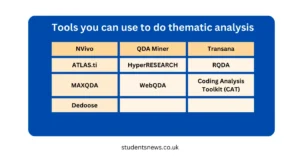Welcome to StudentsNews.co.uk! Often students wonder how to identify themes in qualitative research. This article will help you learn about steps to find themes in qualitative data. Let’s start with the some introduction to qualitative data.
Introduction to Qualitative Data
Qualitative data, often regarded as the heart of social sciences, captures the complexity of human experiences, thoughts, and behaviors. Unlike quantitative data, which is numerical and easily measurable, qualitative data is descriptive and contextual, for example you may want to check themes in an ethical interview.. It includes interviews, focus groups, observations, and open-ended surveys, offering deep insights into the subject matter.
Importance of Theme Identification
Identifying themes in qualitative data is crucial for uncovering patterns and gaining deeper understanding. Themes help in organizing data into coherent categories, making it easier to interpret and draw meaningful conclusions. This process enhances the ability to generate insights that can inform decision-making, policy development, and academic research.
Methods for Collecting Qualitative Data
Various methods are employed to collect qualitative data, each offering unique advantages:
- Interviews: One-on-one conversations providing in-depth insights.
- Focus Groups: Group discussions to explore diverse perspectives.
- Observations: Recording behaviors and interactions in natural settings.
- Surveys: Open-ended questions capturing a wide range of responses.
Steps to Identify Themes in Qualitative Data
1. Understanding the Data
Data Collection
Data collection is the first step in qualitative research where researchers gather information through various methods such as interviews, focus groups, or open-ended surveys. For example, suppose a researcher is studying teachers’ experiences with remote teaching during the pandemic. In this case, they might conduct in-depth interviews with 20 teachers to capture their personal experiences, challenges, and successes. Each interview is designed to be open-ended to allow teachers to express their thoughts freely and provide rich, detailed data.
Data Familiarization
Once the data is collected, the researcher needs to become thoroughly familiar with it. This involves reading and re-reading the interview transcripts, taking notes, and highlighting significant points. For instance, a researcher might note that several teachers mentioned technology difficulties, such as “It was challenging to engage students online due to frequent technical issues.” This initial step helps the researcher immerse themselves in the data, making it easier to identify recurring patterns and themes later on.
2. Data Preparation
Transcription
Transcription is converting spoken words from audio recordings into written text. Accurate transcription is crucial as it ensures that all nuances of the conversation are captured. For example, after interviewing a teacher who shared, “I found it hard to keep the students engaged during online classes because of frequent disruptions,” the researcher would carefully transcribe this verbatim. This step ensures the data is accessible and ready for detailed analysis.
Data Organization
Organizing the data makes it more manageable for analysis. This can be done by labeling each transcript with unique identifiers, such as participant codes (e.g., T1, T2) and organizing them in a spreadsheet or qualitative data analysis software. For instance, the researcher might create a table where each row represents a different interview and each column captures different aspects of the conversation, such as challenges faced, strategies used, and overall experiences.
3. Coding the Data
Initial Coding
Initial coding involves breaking down the data into smaller, meaningful parts and assigning labels (codes) to these parts. These codes represent significant concepts or ideas mentioned by the participants. For example, a researcher might read a transcript and code the statement “Students often complained about poor internet connections” with the code “technology issues.” This process helps to organize the data into categories that can be further analyzed.
Generating Initial Codes
During this stage, the researcher continues to generate codes for the entire dataset, creating a comprehensive list of codes that represent all the significant points mentioned in the data. For instance, other codes might include “student engagement,” “parental involvement,” and “teacher training.” These codes are recorded in a codebook, ensuring consistency in their application across the dataset.
4. Identifying Themes
Searching for Themes
Once the data is coded, the researcher searches for broader patterns or themes by grouping related codes. For example, codes like “technology issues,” “lack of student participation,” and “difficulty in monitoring progress” might be grouped under a theme called “challenges of remote teaching.” This step involves reviewing the codes and determining how they connect to form overarching themes.
Reviewing Themes
Themes are then reviewed to ensure they accurately reflect the data. The researcher goes back to the transcripts to verify that the themes represent the participants’ experiences. For instance, if “challenges of remote teaching” is identified as a theme, the researcher checks if this theme is consistently supported by the data from different interviews and makes adjustments if necessary.
5. Defining and Naming Themes
Defining Themes
Each theme is clearly defined to describe its essence and scope. For example, the theme “challenges of remote teaching” might be defined as encompassing all the difficulties teachers faced, such as technical issues, student engagement, and assessment challenges. This definition ensures that the theme is distinct and covers all relevant aspects.
Naming Themes
Themes are given concise, descriptive names that capture their essence. For instance, instead of a broad name like “problems,” the researcher might use “challenges of remote teaching” to specifically convey the theme’s focus. Clear naming helps in communicating the findings effectively.
6. Reporting Findings
Writing the Report
In this step, the researcher presents the themes along with supporting data excerpts in a detailed report. For example, the theme “challenges of remote teaching” might be illustrated with quotes like, “I struggled to keep students engaged due to frequent technical glitches,” and “Assessing students’ progress was difficult without face-to-face interaction.” This helps to contextualize the themes and demonstrate how they address the research questions.
Validating Findings
To ensure the findings are credible, the researcher might use techniques such as member checking, where participants review the findings to confirm their accuracy, or peer debriefing, where colleagues review and provide feedback on the analysis. These steps help to validate the themes and ensure they accurately reflect the participants’ experiences.
7. Ensuring Rigor and Trustworthiness
Triangulation
Triangulation involves using multiple data sources or methods to verify findings. For example, the researcher might compare interview data with survey responses or classroom observations to see if the same themes emerge. This helps to enhance the credibility of the findings.
Reflexivity
The researcher reflects on their potential biases and how these might affect the analysis. Documenting these reflections helps to maintain objectivity. For instance, if the researcher has a background in teaching, they might note how this perspective could influence their interpretation of the data.
Audit Trail
Maintaining a detailed record of the coding process and theme development provides transparency. The researcher documents each step of the analysis, including decisions made and changes to the themes. This audit trail ensures that others can follow the research process and understand how the conclusions were reached.
By following these steps, researchers can systematically identify and analyze themes in qualitative data, ensuring a thorough and credible interpretation of the data.
Preparing Data for Analysis
Before analysis, qualitative data must be meticulously prepared:
- Transcription: Converting audio or video recordings into text.
- Data Cleaning: Removing irrelevant information and errors.
- Organizing Data: Structuring data into manageable formats for analysis.
Techniques for Theme Identification
Several techniques are used to identify themes within qualitative data:
- Coding: Labeling segments of data with descriptive tags.
- Categorization: Grouping similar codes into broader themes.
- Pattern Recognition: Detecting recurring elements across the dataset.
Coding Techniques
Coding is a fundamental step in thematic analysis, involving different approaches:
- Open Coding: Initial coding to capture diverse ideas.
- Axial Coding: Linking codes to identify relationships.
- Selective Coding: Focusing on core themes that represent the data.
Software Tools for Qualitative Analysis

Advanced software tools facilitate qualitative data analysis:
- NVivo: Powerful tool for coding and pattern identification.
- Atlas.ti: Comprehensive platform for qualitative data management.
- MAXQDA: Versatile software supporting various analysis techniques.
Challenges in Identifying Themes
Identifying themes in qualitative data presents several challenges:
- Subjectivity: Personal biases influencing interpretation.
- Bias: Preconceived notions affecting analysis outcomes.
- Data Overload: Managing and synthesizing large volumes of data.
Ensuring Credibility and Trustworthiness
Maintaining credibility and trustworthiness in qualitative research is essential:
- Validation Techniques: Using triangulation to cross-check data.
- Reliability Measures: Ensuring consistency in coding and analysis.
Ethical Considerations
Ethical considerations are paramount in qualitative research:
- Informed Consent: Ensuring participants are fully aware of the study.
- Anonymity: Protecting the identities of participants.
- Data Security: Safeguarding sensitive information.
FAQs
What is qualitative data?
Qualitative data encompasses non-numerical information that provides detailed descriptions and insights into various phenomena. It includes interviews, observations, and open-ended survey responses.
How do you identify themes in qualitative data?
Themes are identified through coding, categorization, and pattern recognition techniques, often supported by software tools designed for qualitative analysis.
What are the challenges of thematic analysis?
Challenges include managing subjectivity, avoiding bias, and handling large volumes of data. Ensuring consistency and reliability in coding is also critical.
What tools are available for qualitative data analysis?
Popular tools include NVivo, Atlas.ti, and MAXQDA, which offer functionalities for coding, categorizing, and identifying patterns in qualitative data.
How can I ensure my qualitative research is credible?
Credibility can be ensured through validation techniques like triangulation, maintaining consistency in coding, and involving peer reviews.
What ethical considerations should I keep in mind?
Researchers must ensure informed consent, protect participant anonymity, and secure sensitive data throughout the research process.



[…] Finding themes in Qualitative Data: Step-by-step Guide […]